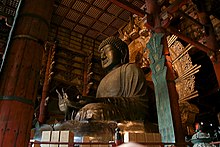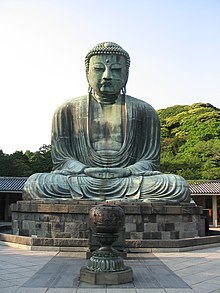Daibutsu
Appearance
Look up 大仏 in Wiktionary, the free dictionary.



Daibutsu (大仏 or in traditional orthography (kyūjitai) 大佛) is a Japanese word meaning literally "Large Buddha" that refers to large statues of the Buddha or one of his various incarnations.
List of Daibutsu
(List by size)
- Ushiku Great Buddha, in Ibaraki Prefecture, 120 metres (393.7 ft) tall in total with a 10 metres (32.8 ft) base, is Japan's largest daibutsu
- The Daibutsu of Nihon-ji at Nokogiriyama in Chiba Prefecture, built in 1783 and restored in 1969, is Japan's largest stone carved daibutsu with 31.05 metres (101.9 ft) tall
- Echizen Great Buddha, 17 metres (55.8 ft) tall [1]
- Ganmen Great Buddha in Hiraizumi, Iwate Prefecture: This 16.5 metres (54.1 ft) high buddha is one of the five large Buddhas in Japan and is known as the Northern Rock Buddha. It depicts Amida Butsu and commemorates the deaths of soldiers in two local wars in the 11th century. Originally it was a full Buddha seated in heaven but the body was destroyed in an earthquake in 1896. [2]
- Great Buddha of Takaoka - Takaoka in Toyama Prefecture has the self-proclaimed "Number 3 Great Buddha of Japan," but it is not actually the third largest. It is 15.85 metres (52.0 ft) from the ground to the halo, but the statue itself is only about half that height.[citation needed]
- Great Buddha of Nara, in Tōdai-ji (752), 14.98 metres (49.1 ft) tall. It is part of the "Historic Monuments of Ancient Nara" UNESCO World Heritage Site.
- Gifu Great Buddha, 13.7 metres (44.9 ft) tall, located in Shōhō-ji, Gifu, Gifu Prefecture[3]
- Kamakura Great Buddha (1252), 13.35 metres (43.8 ft) tall. In the West, the term is often used to refer to the Kamakura Great Buddha following its popularization in the poem "The Buddha at Kamakura" by Rudyard Kipling.
- Tokyo Great Buddha in Itabashi, Tokyo, 8.2 metres (26.9 ft) tall (sitting) in total. Located at Jorenji temple 20 minutes from Narimasu Station, this Great Buddha resembles the one in Kamakura, except it is coal black and a bit more svelte, despite weighing 30 tons. It's also a baby as Great Buddhas go, built only in 1977.
- Kamagaya Great Buddha in Kamagaya, Chiba Prefecture, 2.3 metres (7.5 ft) tall in total with a 0.5 metres (1.6 ft) base, is Japan's smallest daibutsu.
- The Daibutsu of Hōkō-ji in Kyoto (16th-20th centuries) was destroyed by a series of earthquakes and fires and has not been rebuilt after the last disaster which happened in the 1970s
- Showa Daibutsu, at Seiryū-ji in Aomori, Aomori Prefecture
References
- ^ Katsuyama History. Katsuyama City Hall. Retrieved December 4, 2007.
- ^ Takkoku no Iwaya Bishamondō: Visitor information pamphlet. Published by Betto Takkoku Seikōji, ph.(0191)46-4931
- ^ Gifu Shouhouji Daibutsu. Shohoji. Retrieved December 4, 2007.
External links
Wikimedia Commons has media related to Category:Buddha statues in Japan.
